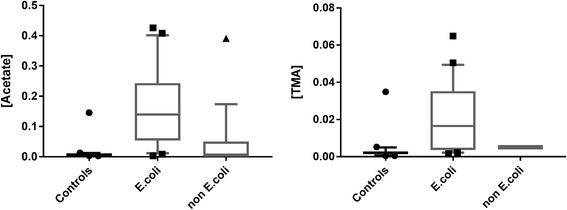1H NMR spectroscopy-based metabolomics analysis for the diagnosis of symptomatic E. coli-associated urinary tract infection (UTI)
- PMID: 28934947
- PMCID: PMC5609053
- DOI: 10.1186/s12866-017-1108-1
1H NMR spectroscopy-based metabolomics analysis for the diagnosis of symptomatic E. coli-associated urinary tract infection (UTI)
Abstract
Background: Urinary tract infection (UTI) is one of the most common diagnoses in girls and women, and to a lesser extent in boys and men younger than 50 years. Escherichia coli, followed by Klebsiella spp. and Proteus spp., cause 75-90% of all infections. Infection of the urinary tract is identified by growth of a significant number of a single species in the urine, in the presence of symptoms. Urinary culture is an accurate diagnostic method but takes several hours or days to be carried out. Metabolomics analysis aims to identify biomarkers that are capable of speeding up diagnosis.
Methods: Urine samples from 51 patients with a prior diagnosis of Escherichia coli-associated UTI, from 21 patients with UTI caused by other pathogens (bacteria and fungi), and from 61 healthy controls were analyzed. The 1H-NMR spectra were acquired and processed. Multivariate statistical models were applied and their performance was validated using permutation test and ROC curve.
Results: Orthogonal Partial Least Squares-discriminant Analysis (OPLS-DA) showed good separation (R2Y = 0.76, Q2=0.45, p < 0.001) between UTI caused by Escherichia coli and healthy controls. Acetate and trimethylamine were identified as discriminant metabolites. The concentrations of both metabolites were calculated and used to build the ROC curves. The discriminant metabolites identified were also evaluated in urine samples from patients with other pathogens infections to test their specificity.
Conclusions: Acetate and trimethylamine were identified as optimal candidates for biomarkers for UTI diagnosis. The conclusions support the possibility of a fast diagnostic test for Escherichia coli-associated UTI using acetate and trimethylamine concentrations.
Keywords: 1H NMR spectroscopy; Acetate; E. coli; ROC curve; Trimethylamine; UTI.
Conflict of interest statement
Ethics approval and consent to participate
The aim of the study was to develop and test a new methodology, targeting the bacteria and their metabolites, in absence of any invasive procedure and without involvement of therapeutic medications. All human data were anonymized and no identifiable personal information of the subjects included in the study was available. This information has been provided to the Independent Ethics Committee (C.E.I.) of the Cagliari University Hospital (AOU) that, according to the guidelines of the Italian Drug Agency, ruled out a formal approval in this case.
Urine samples from the healthy control group were collected after subjects gave verbal informed consent for participation in this research study.
Consent for publication
Not applicable.
Competing interests
The authors declare that they have no competing interests.
Publisher’s Note
Springer Nature remains neutral with regard to jurisdictional claims in published maps and institutional affiliations.
Figures



References
-
- Mehenert-Kay SA. Diagnosis and management of uncomplicated urinary tract infections. Am Fam Physician. 2005;72:451–456. - PubMed
-
- Gupta K, Hooton TM, Naber KG, Wullt B, Colgan R, Miller LG, Moran GJ, Nicolle LE, Raz R, Schaeffer AJ, Soper DE; Infectious Diseases Society of America; European Society for Microbiology and Infectious Diseases. International clinical practice guidelines for the treatment of acute uncomplicated cystitis and pyelonephritis in women: A 2010 update by the Infectious Diseases Society of America and the European Society for Microbiology and Infectious Diseases. Clin Infect Dis. 2011;52:e103-e120. - PubMed
MeSH terms
Substances
LinkOut - more resources
Full Text Sources
Other Literature Sources
Medical
Miscellaneous

